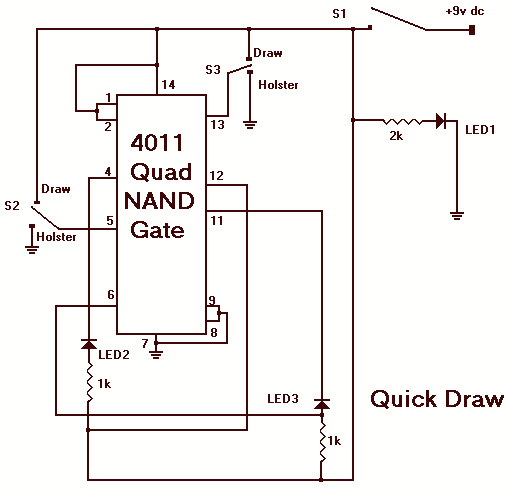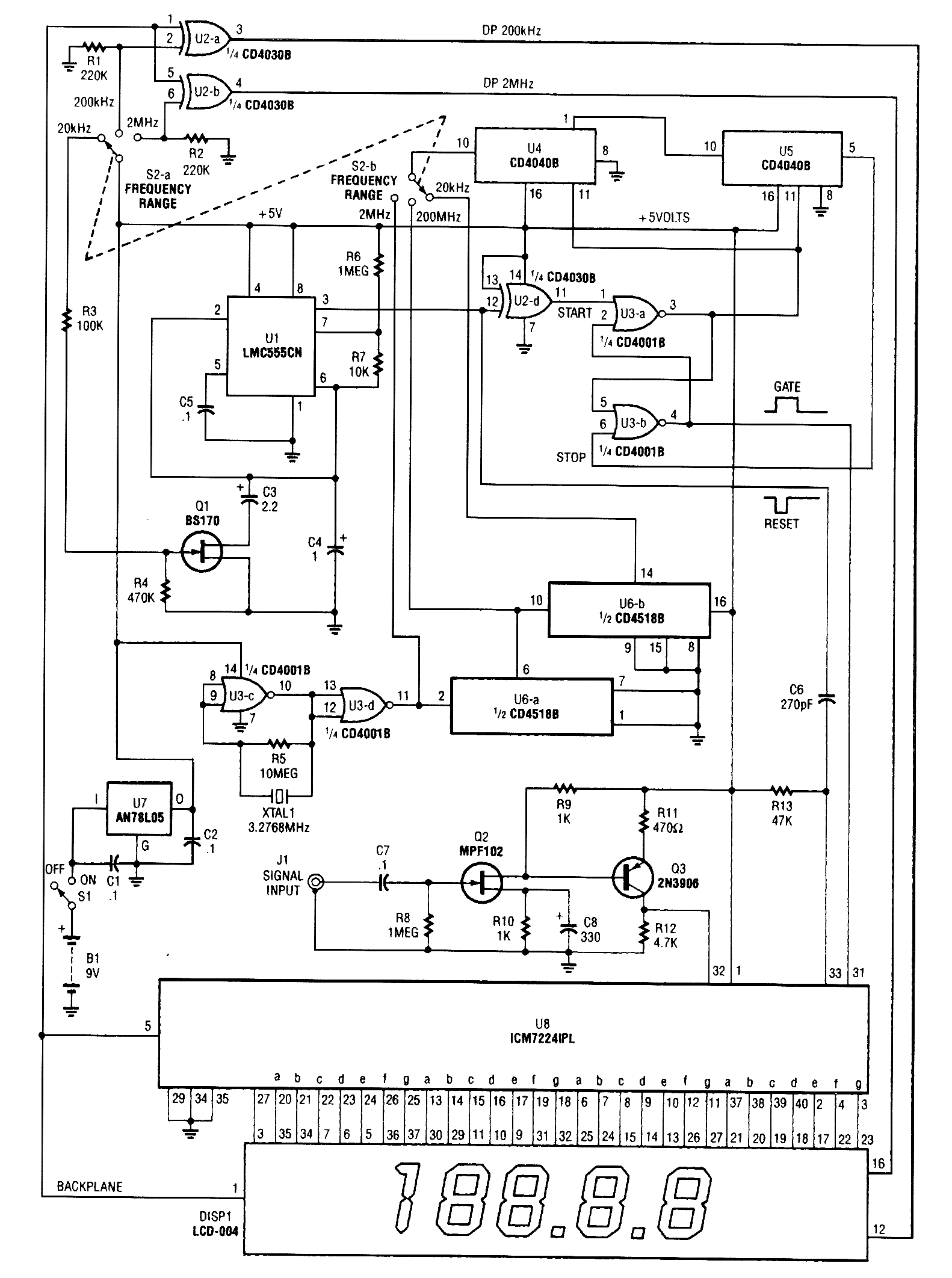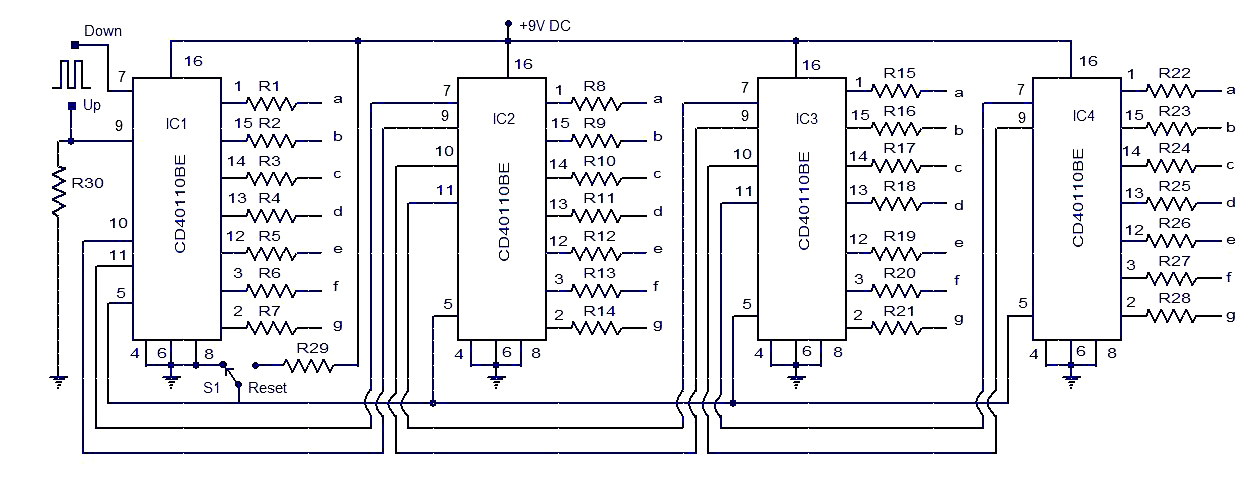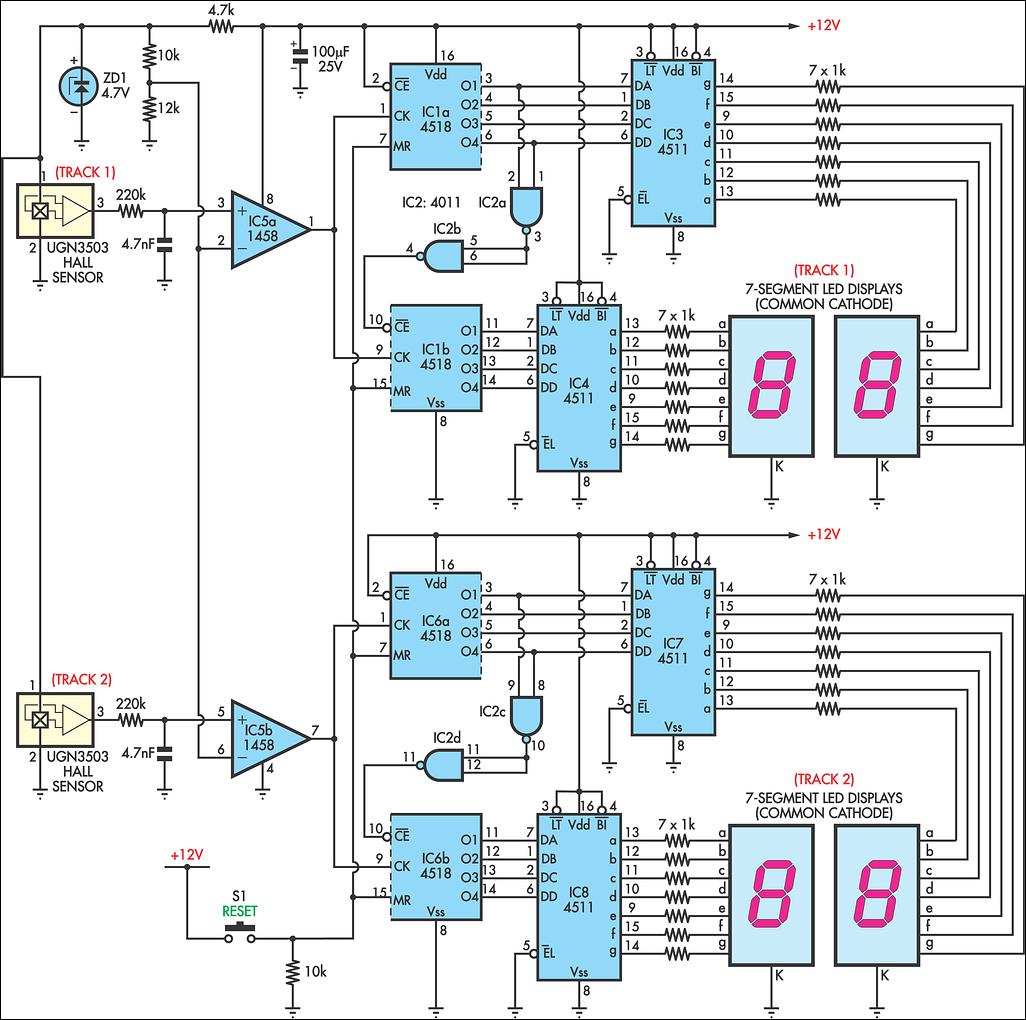
quick counter for young
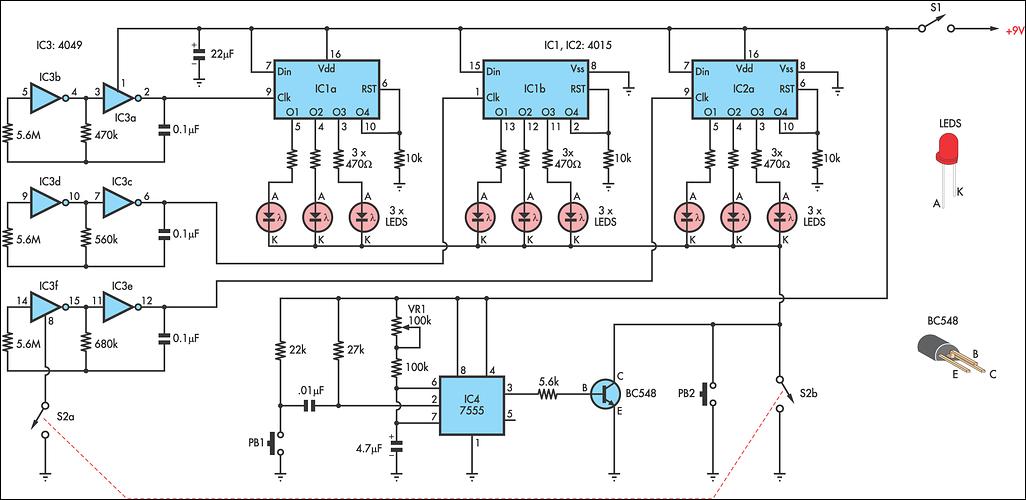
This circuit is designed as a toy to help young children learn to count. The power is activated by switch S1, and then switch S2 is closed, causing nine LEDs to flash slowly. When S2 is opened, the LEDs turn off. Pressing push-button PB1 briefly illuminates a random number of LEDs, which the children are encouraged to count. The counted numbers can be verified by pressing PB2, which keeps the same LEDs lit for an adjustable duration. The circuit functions as follows: IC3 is a 4049 hex inverter configured as three oscillators operating at different frequencies, activated by closing switch S2a. The clock pulses generated by IC3 drive both halves of IC1 and one half of IC2, both of which are 4015 dual 4-stage shift registers. Each shift register sequentially activates its four outputs: first output high, then first and second, followed by first, second, and third, and finally all four. However, as the fourth output is connected to the reset line of its own section, the shift register resets to zero. Outputs 1, 2, and 3 from all three shift registers are linked to the nine LEDs, whose cathodes connect to a common rail grounded via switch S2b when S2 is closed. When S2 is opened, the three oscillators cease operation, but a random number of LEDs remains connected to the high outputs of the 4015s. This number can be briefly displayed by pressing PB1, which triggers the 7555 timer in monostable mode, providing a short output that activates transistor Q1, connecting the LED cathodes to ground. The duration of this viewing time is adjustable with variable resistor VR1. To verify a count, pressing PB2 maintains the illumination of the same LEDs for as long as desired. The LEDs are arranged in a 3x3 grid with connections distributed across the layout; for instance, the first row does not consist solely of the three LEDs from the first half of IC1. It is important to note that, unlike standard dice, a number such as 5 can appear in various configurations, making pattern recognition ineffective. Additionally, this circuit does not function as a traditional nine-output true dice, as the numbers do not appear with equal frequency.
The circuit utilizes a combination of digital logic components and timing circuits to create an interactive counting experience for children. The 4049 hex inverter serves as the core oscillator, generating clock pulses that synchronize the operation of the shift registers. The 4015 shift registers are crucial for controlling the sequential illumination of the LEDs, allowing for a random selection of lit outputs that can be visually counted by children.
The integration of the 7555 timer in monostable mode enhances the user experience by providing a controlled viewing period for the counted LEDs. The adjustable viewing time, facilitated by VR1, allows for tailored interaction based on the child's counting ability. The use of push buttons PB1 and PB2 provides a simple and intuitive interface for children to engage with the toy, reinforcing their counting skills through interactive play.
The design also emphasizes variability and unpredictability in the counting process, as the arrangement of the LEDs and the random selection mechanism ensure that each counting session is unique. This unpredictability, coupled with the non-linear arrangement of the LEDs, encourages children to focus on counting rather than relying on visual patterns, thus enhancing their cognitive skills in a playful manner.
Overall, this circuit presents a creative and educational tool that combines electronics with early childhood learning, making it an effective aid for teaching counting in an engaging way.This circuit is a toy to encourage young children to count. Power is turned on by switch S1, then S2 is closed. This makes nine LEDs flash slowly. S2 is then opened and the LEDs go out. Pressing push-button PB1 turns on a random number of LEDs - briefly - during which time they are to be counted. The number counted can be checked by pressing PB2 w hich turns the same LEDs on for as long as needed. Then repeat. The circuit works as follows: IC3 is a 4049 hex inverter connected as three oscillators running at different rates. It is turned on by closing switch S2a. The clock pulses from IC3 drive both halves of IC1 and one half of IC2, both being 4015 dual 4-stage shift registers.
Each shift register has four outputs which go high in order: 1, 1 and 2; 1 and 2 and 3; 1 and 2 and 3 and 4. However as output 4 is connected to the reset line of its own half - the shift register resets to zero.
Outputs 1, 2 & 3 of all three shift registers are connected to nine LEDs, the cathodes of which go to a common rail. This rail is connected to ground via S2b when switch S2 is closed. When S2 is opened the three oscillators stop but a random number of LEDs is still connected to the high outputs of the 4015s.
That number can be viewed briefly by pressing PB1 which pulses the 7555 timer in monostable mode, to give a short duration output which drives Q1 and connects the LED cathodes to 0V. The viewing time is adjustable by VR1. Checking a count is done by pressing PB2 which holds the same LEDs on as long as desired. The LEDs are set in a 3 x 3 grid with the connection scattered, ie, the first row is not the three LEDs from the first half of IC1.
Note that, unlike the usual dice, a number such as 5 can appear in many formats, so pattern recognition is no help. Also note that this is not a nine output true dice - because the numbers do not come up with equal frequency.
🔗 External reference
The circuit utilizes a combination of digital logic components and timing circuits to create an interactive counting experience for children. The 4049 hex inverter serves as the core oscillator, generating clock pulses that synchronize the operation of the shift registers. The 4015 shift registers are crucial for controlling the sequential illumination of the LEDs, allowing for a random selection of lit outputs that can be visually counted by children.
The integration of the 7555 timer in monostable mode enhances the user experience by providing a controlled viewing period for the counted LEDs. The adjustable viewing time, facilitated by VR1, allows for tailored interaction based on the child's counting ability. The use of push buttons PB1 and PB2 provides a simple and intuitive interface for children to engage with the toy, reinforcing their counting skills through interactive play.
The design also emphasizes variability and unpredictability in the counting process, as the arrangement of the LEDs and the random selection mechanism ensure that each counting session is unique. This unpredictability, coupled with the non-linear arrangement of the LEDs, encourages children to focus on counting rather than relying on visual patterns, thus enhancing their cognitive skills in a playful manner.
Overall, this circuit presents a creative and educational tool that combines electronics with early childhood learning, making it an effective aid for teaching counting in an engaging way.This circuit is a toy to encourage young children to count. Power is turned on by switch S1, then S2 is closed. This makes nine LEDs flash slowly. S2 is then opened and the LEDs go out. Pressing push-button PB1 turns on a random number of LEDs - briefly - during which time they are to be counted. The number counted can be checked by pressing PB2 w hich turns the same LEDs on for as long as needed. Then repeat. The circuit works as follows: IC3 is a 4049 hex inverter connected as three oscillators running at different rates. It is turned on by closing switch S2a. The clock pulses from IC3 drive both halves of IC1 and one half of IC2, both being 4015 dual 4-stage shift registers.
Each shift register has four outputs which go high in order: 1, 1 and 2; 1 and 2 and 3; 1 and 2 and 3 and 4. However as output 4 is connected to the reset line of its own half - the shift register resets to zero.
Outputs 1, 2 & 3 of all three shift registers are connected to nine LEDs, the cathodes of which go to a common rail. This rail is connected to ground via S2b when switch S2 is closed. When S2 is opened the three oscillators stop but a random number of LEDs is still connected to the high outputs of the 4015s.
That number can be viewed briefly by pressing PB1 which pulses the 7555 timer in monostable mode, to give a short duration output which drives Q1 and connects the LED cathodes to 0V. The viewing time is adjustable by VR1. Checking a count is done by pressing PB2 which holds the same LEDs on as long as desired. The LEDs are set in a 3 x 3 grid with the connection scattered, ie, the first row is not the three LEDs from the first half of IC1.
Note that, unlike the usual dice, a number such as 5 can appear in many formats, so pattern recognition is no help. Also note that this is not a nine output true dice - because the numbers do not come up with equal frequency.
🔗 External reference
